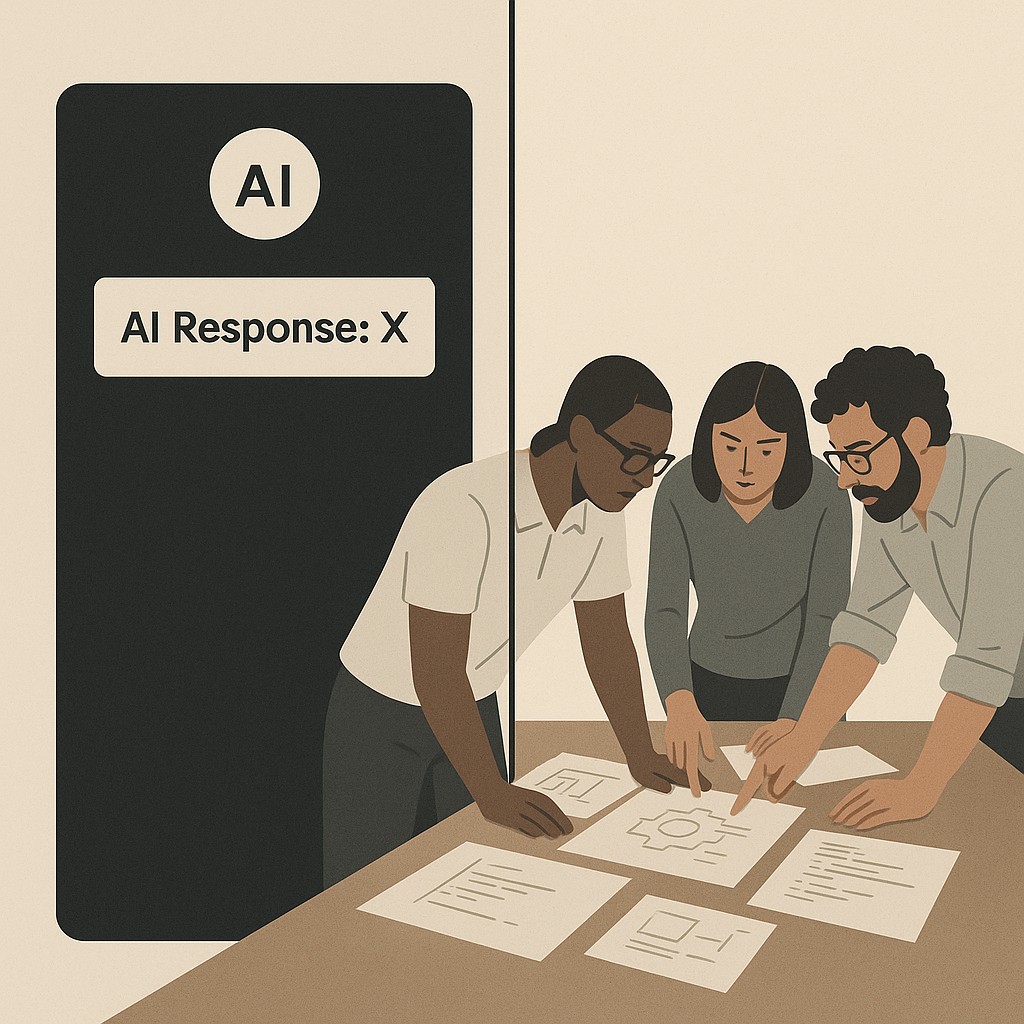Design Friction to Maintain Engineering Rigor with AI
Design Friction to Maintain Engineering Rigor with AI

When Fast Answers Kill the Debate
It hit me a few days ago while reading a post arguing that Stack Overflow—despite all its quirks—really made you sharpen your questions. I used to spend hours there, rewriting the same post just to clarify an assumption, then sticking around to defend it when someone poked a hole I hadn’t considered.
These days? I catch myself pasting a one-liner into a prompt, get an answer that sounds plausible, and move on. It’s efficient. But if I’m honest, I miss the arguments—the part where bad ideas got exposed and you actually felt a bit uncomfortable.
That’s the dangerous part, not the error, but the illusion of confidence. Fluent, repeated exposure easily convinces us something is more accurate—even when it isn’t—unless we’re prompted to actually rate truthfulness instead of just interest, which means surface certainty often slips by unnoticed link. Chain-of-Verification methods help teams maintain engineering rigor with AI by having the AI generate challenges to its own answers, catching contradictions before assumptions calcify link. If no one asks “why,” shallow mistakes keep slipping by and the review process becomes theater.

So here’s the core shift. We actually have to design friction in. Otherwise, the habit of justifying work, challenging assumptions, and demanding evidence evaporates. If we want real rigor, we need prompts, reviews, stand-ups—whatever it takes—to put “why” reasoning back in the flow.
Questioning Is How We Learn
On Stack Overflow, everything slowed down. You couldn’t hand-wave a technical problem; someone would show up in the comments and ask you to clarify. Suddenly, you had to make your thinking visible—what you actually tried, what you knew, and what you couldn’t prove yet. It wasn’t just pain for pain’s sake. Struggle isn’t just pain—it’s proven to build long-term learning and transfer; desirable difficulties lead to deeper results by making you work for insight. What looked like delay was really the process of learning dressed up as argument. Stack Overflow wasn’t perfect, but it made you ask better questions. That process? It was learning in disguise.
The same thing happened in blog comments and YouTube threads. Arguments broke out, and the only thing we always agreed on was that debating made us smarter. Consensus was rare, but I walked away sharper, every time.
Funny how those debates stuck with me. Back when I started doing code reviews, I went into my first team meeting thinking I knew exactly how a two-pointer algorithm should work for deduping. Five minutes later, someone caught an edge case I’d missed, and I had to admit I hadn’t tested for negative indices at all. It spun off into whether Python’s enumerate would bail out if we modified the list in place, which—surprisingly—can trigger some subtle bugs if you’re not paying attention. I still catch myself side-eyeing enumerate for that reason.
That kind of scrutiny followed me into code reviews and design discussions. With AI code review rigor, you learn to anticipate questions about tradeoffs—what’s the real cost of switching libraries, or why rely on that edge-case behavior? You start defending your choices with evidence, rather than gut feeling. It’s almost like you’re practicing for future debates without even realizing it. Knowing someone might challenge your assumptions forces you to check them twice. If I missed something subtle, someone in the room would find it.
But we’re not going back to Stack Overflow. The point isn’t nostalgia—it’s about re-creating that productive friction inside our new workflows, wherever we land.
Patterns for Deliberate Friction to Maintain Engineering Rigor with AI
Let’s be clear. AI does not create tension on its own. If you want your team to ask smart questions and defend their choices, your workflow needs to force that conversation, not just assume it will happen.
One pattern I use now—every single time I prompt—starts like this: to practice critical thinking with AI, I skip “How do I do X?” and instead tell the AI what I’ve already tried, list out what’s unclear, and then ask, “What am I missing here?” It’s a small change, but it forces you to show your work and admit uncertainty up front. Maybe you feel tempted to hide those gaps, keep things neat. But that’s exactly what blindsides you later. Once I started prompting this way, I noticed framing cuts down back-and-forth, which stabilizes outputs and keeps the real issues visible. Try it a few times and see where your mental shortcuts get exposed.
The next step is simple. Whenever you generate output—whether it’s code, a design doc, or an architecture diagram—use AI prompts for reasoning and add an assumption ledger. Explicitly tag anything you’re unsure about, almost like little unit test markers on your reasoning. If two teammates read the output, they’ll see not only the answer, but the caveats: what’s presumed, what needs checking, which parts feel sketchy. It’s a subtle way to shift reviews from “does this work” to “are the risks visible?” The assumption ledger is boring until it isn’t; the one caveat everybody ignored is always the one that blows up on launch day.
Here’s another friction point I recommend baking in. Before any AI answer gets merged, require three things—a short “why” defense explaining the reasoning behind the suggestion, a scan for possible counterexamples, and a list of named tradeoffs. You’re forcing the review to surface real choices, not just accept plausible output. Stack Overflow debates made this second nature; now, you have to design it back into the workflow.
There’s an old cooking metaphor that fits here. Following a recipe exactly makes sense up to a point, but unless you taste and adjust—maybe add salt, maybe drop the sugar—it’s never quite right. That friction, that moment when you pause and check, is the flavor. If you automate out every adjustment, you lose what makes the dish interesting. I used to see friction as wasted time; now I see it as the key ingredient to not making the same bland solution over and over.
Finally, make every workflow pass through a red-team counterprompt phase. For any major AI suggestion, ask explicitly: “Where could this fail?” Then, map each risk onto a test, a monitoring guard, or a mitigation plan before pushing forward. You’d be shocked how many hidden failures surface this way. Even if it adds a few minutes—trust me, those are minutes that save hours of debugging. Just like old code reviews, the challenge isn’t personal. It’s the system catching what we’re all too likely to miss.
Put these patterns on repeat, and you won’t just slow down—you’ll sharpen your entire team’s quality. The debate returns, but it’s targeted, lightweight and designed to scale. That’s how you maintain engineering rigor with AI, even as the tools keep getting smarter.
Ritualizing Questioning and Defense in AI Workflows
We’ve streamlined away the struggle. But friction is where growth lives. If you want a team to keep its edge, set the expectation up front. Every AI-assisted change ships with explicit rationale, uncertainties, and tradeoffs. Not just what’s new, but why it matters—and where it might break. You’d be surprised how quickly people shift their thinking when defending those points becomes standard, not optional.
So let’s make that visible. Update your PR templates. Add required fields for “why” reasoning, alternatives considered, counterexample checks, and a short risk mitigation note. It sounds bureaucratic, but it’s not. You’re moving from “Does this work?” to “Why would this not work?” The change is subtle, but the difference in review quality is dramatic. Give reviewers something to push against, so they stop rubber-stamping plausible outputs and start spotting subtle cracks before they matter.
Design discussions need an upgrade too. Assign a challenger role for every major decision—someone whose job is to poke holes, not just nod. Have the team log assumptions in the meeting notes and build out simple tradeoff tables, capturing not just your favored path but the AI-generated alternatives and their concrete constraints. Maybe option A is fast but fragile, while B is slower but resilient. Document it all, so when things get messy six months later, you can trace back who asked which question and why that answer held.
That callback from earlier about documenting tradeoffs—this is where it becomes invaluable. I’ve found that once these habits go from “good idea” to standard ritual, the team gets braver. People surface what feels risky, defend choices out loud, and trust the process instead of just the tool.
It’s not about slowing for the sake of it. Deliberate friction keeps hidden failures from sneaking through and strengthens engineering rigor in AI at scale, long after the first draft is obsolete. Maybe you’ll lose a bit of velocity in the short run. But it’s tradeoffs out in the open—not hidden away under product gloss—that keep engineering honest and teams sharp.
Small Friction, Big Protection
Slowing down feels risky when deadlines loom. I get why you might hesitate to add another checkpoint or force the team to spell out uncertainties. But here’s the reframing that helped me stop seeing friction as wasted time—it’s insurance. The hard truth is, skipping the uncomfortable “why” questions up front pushes risk farther down the road, where it can get expensive and public. The extra step isn’t overhead. It’s what prevents those silent failures from multiplying and turning into rework that nobody budgeted for—or into the kind of bug customers write about online. Yes, it sounds slower, but that’s the speed that actually preserves your reputation.
We’ve all shipped features that looked solid, only to learn later we missed something dumb—an off-by-one error, a query that tanks performance in production, or a pattern borrowed from a Stack Overflow post and misapplied to a slightly different context. These slip through especially fast when the answer is fluent and sounds confident. Quick, polished output is great at hiding subtle mistakes and eroding the habit of double-checking core logic.
This may sound abstract, but you can quantify the upside. Start tracking three things: defects flagged by counterprompts, decision reversals avoided by surfacing tradeoffs, and hours saved downstream by catching issues before release. You don’t have to overhaul every process at once. Pilot this on one team with one critical workflow for a week.
Have your reviewers note where explicit “why” reasoning caught uncertainty or exposed a hidden risk. The result? You’ll see that the small investments compound quickly—fewer rollback deployments, less hunting for root causes at midnight, more on-time launches. I started doing this myself, and the feedback loop was immediate: the team knew what details actually mattered, and our planning sessions got sharper with fewer surprises. The friction you build in doesn’t stop progress; it shapes it. If you’re thinking ahead, consider how this scales—each small, visible habit creates a culture where speed and scrutiny support each other, not compete.
We built a simple app for engineers: generate AI-powered posts, summaries, and docs fast, with controls for goals, constraints, and tone, so you can publish without babysitting prompts.
I haven’t figured out how to always balance scrutiny and velocity. Some sprints, urgency takes over no matter what rituals you embed. For now, the tension is just part of the job.
So if you’re leading teams in this new AI-driven world, here’s your move: pair speed with rigor by designing the questions back in, and make the intent visible and the habit repeatable. If AI gives answers, who’s still asking the right questions?
Enjoyed this post? For more insights on engineering leadership, mindful productivity, and navigating the modern workday, follow me on LinkedIn to stay inspired and join the conversation.
You can also view and comment on the original post here .
